
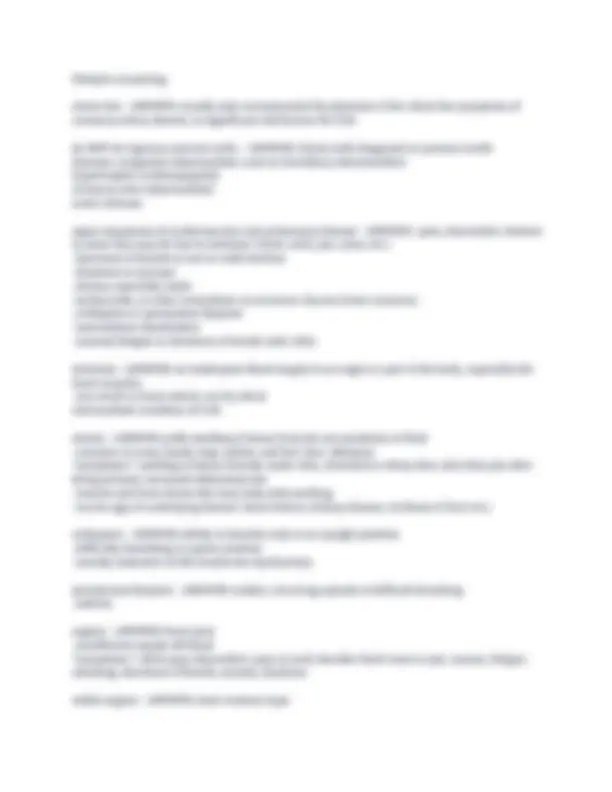
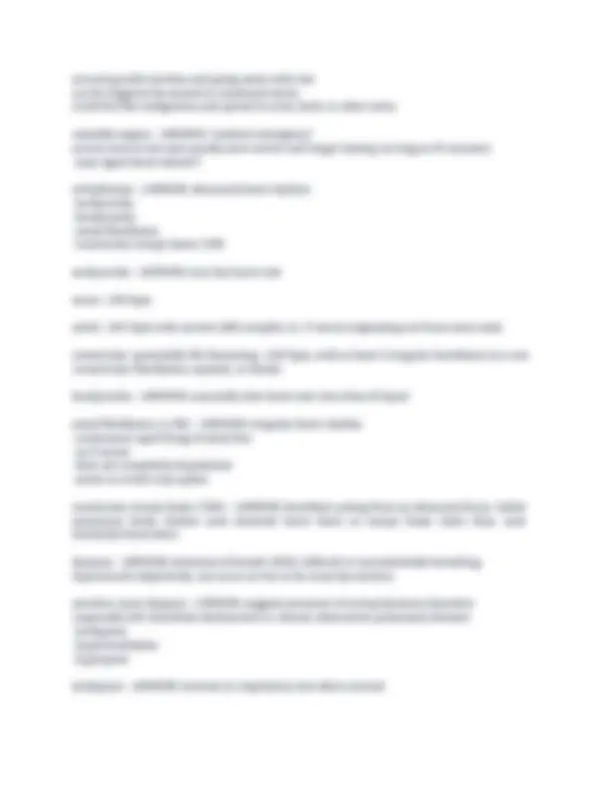
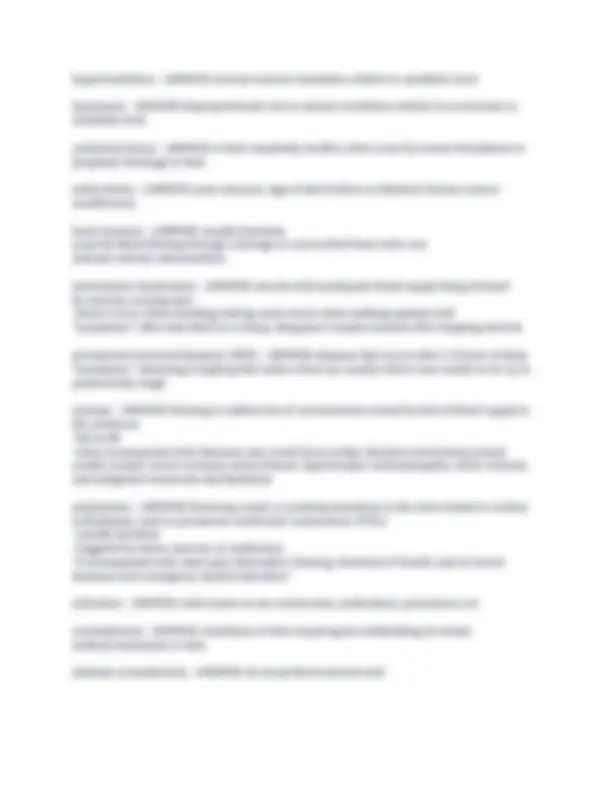
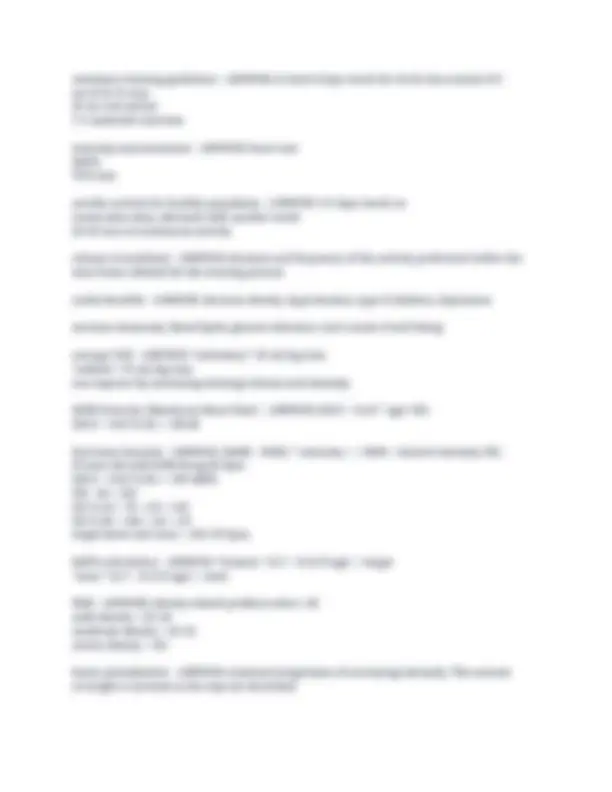
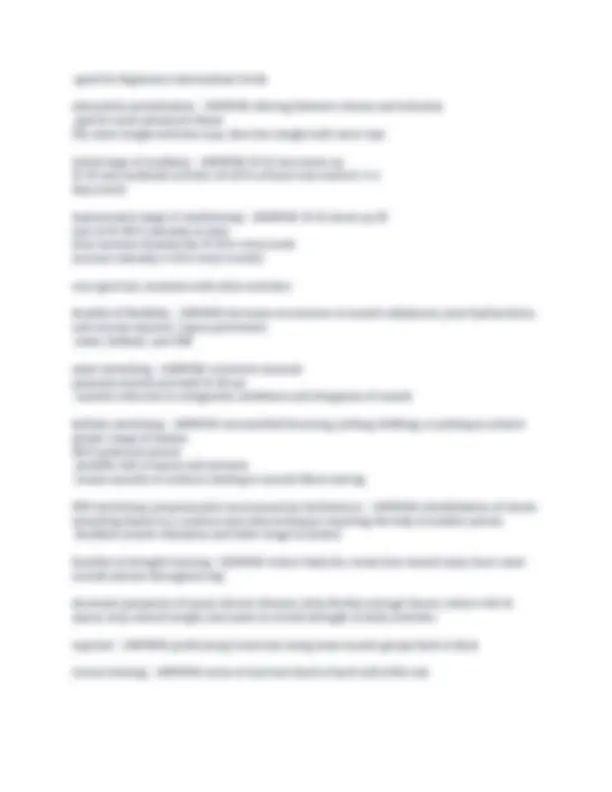
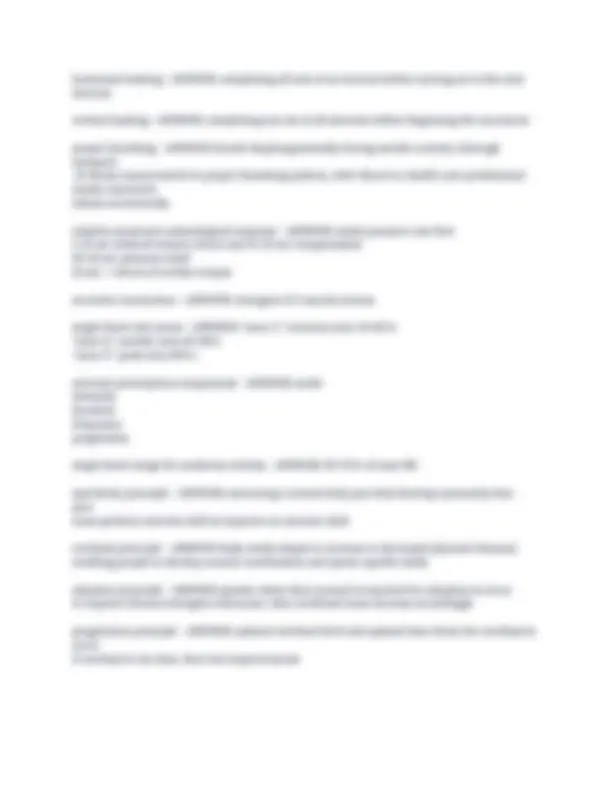
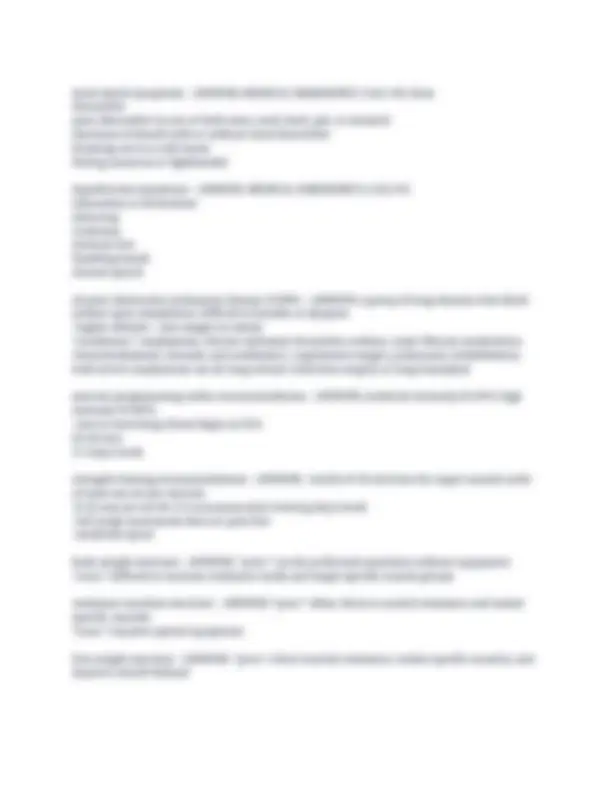
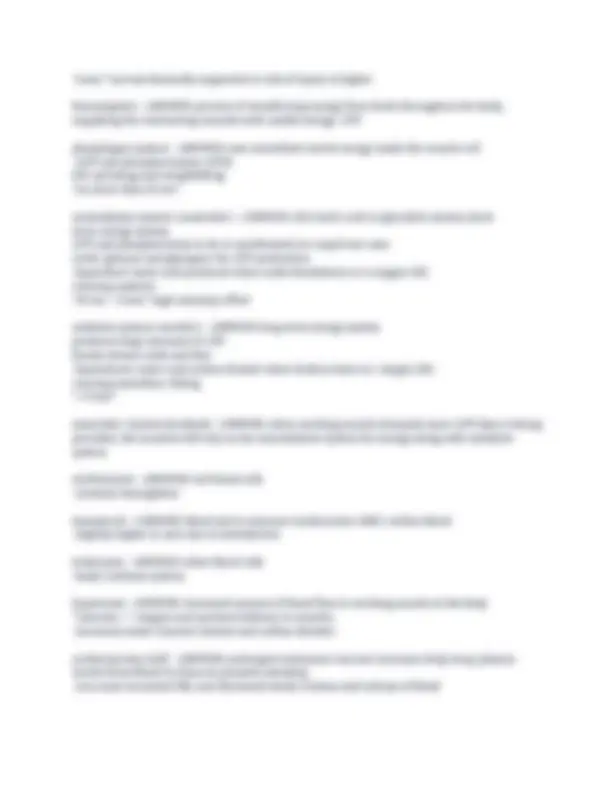
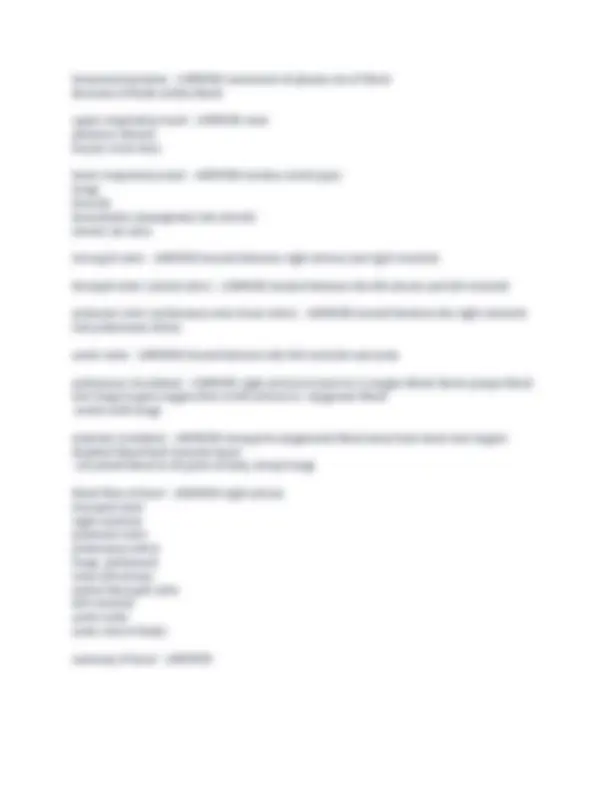
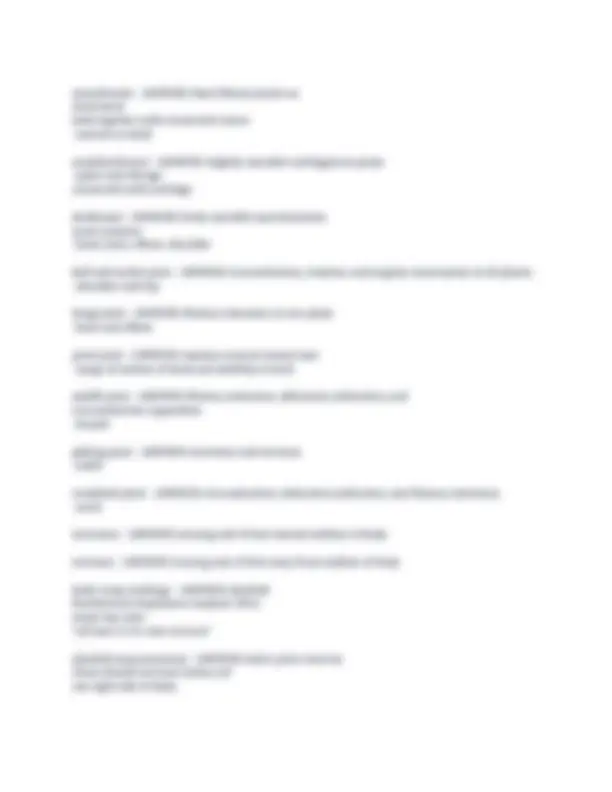
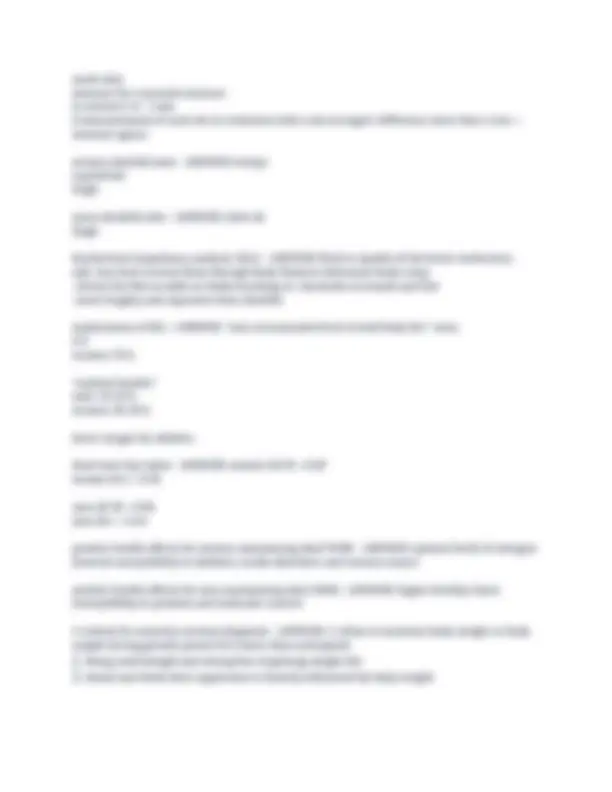
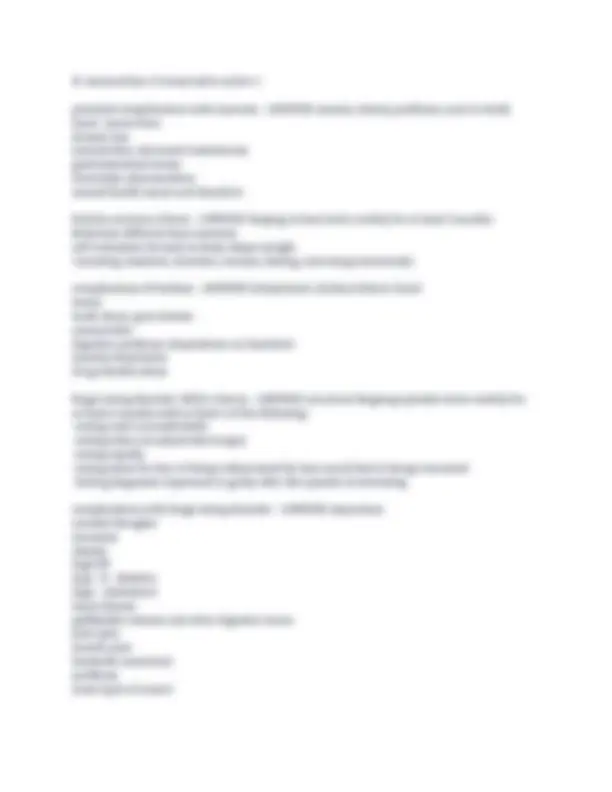
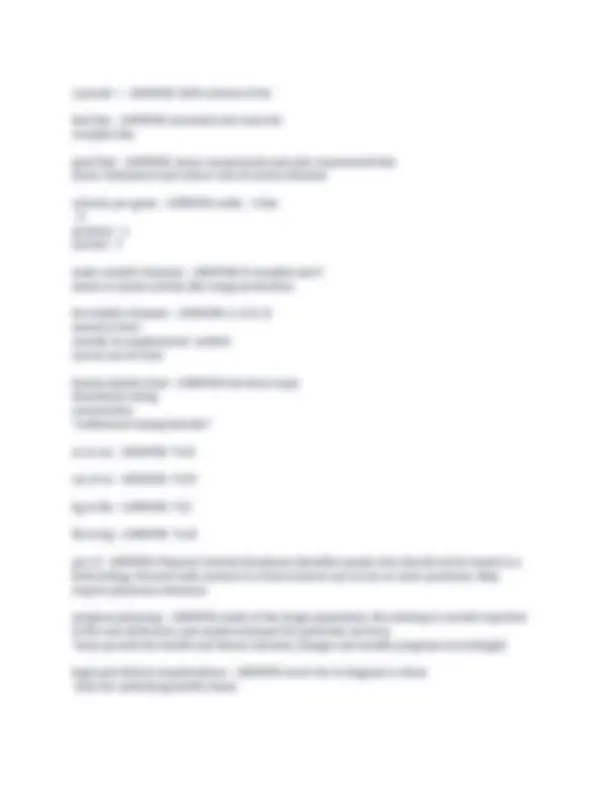
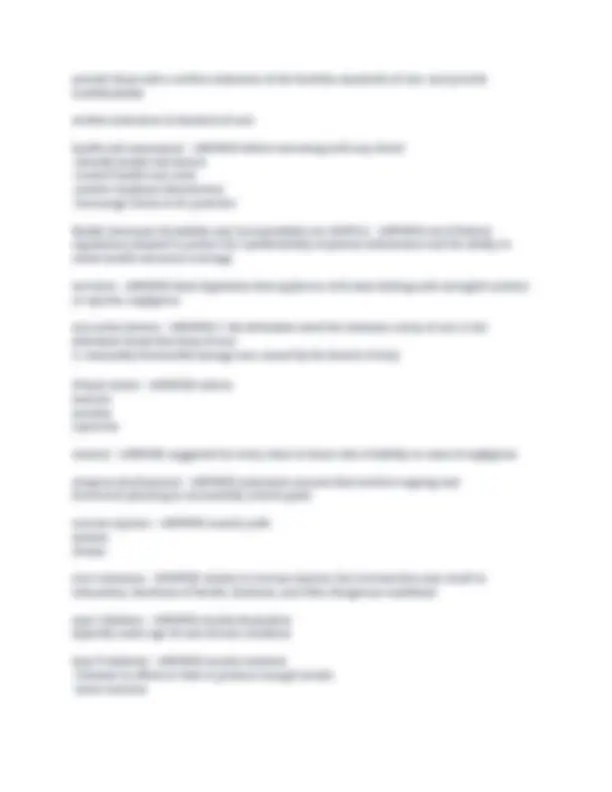
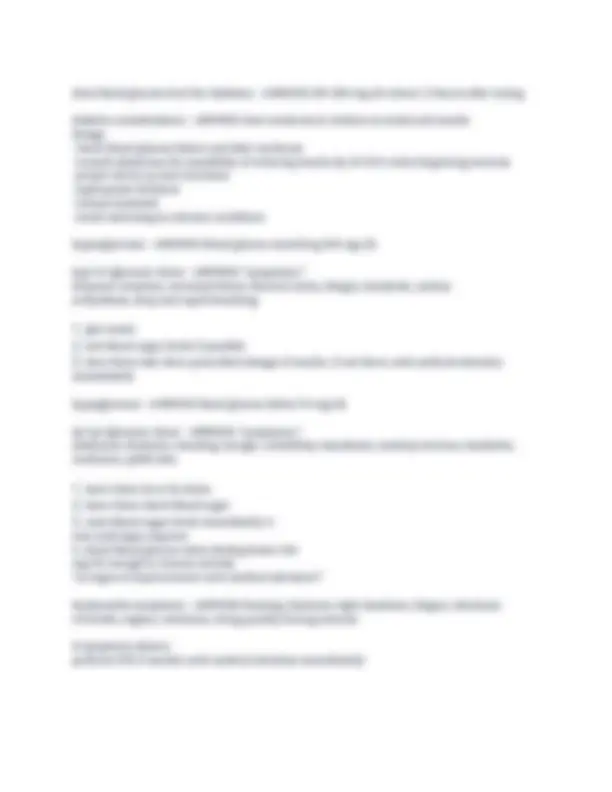
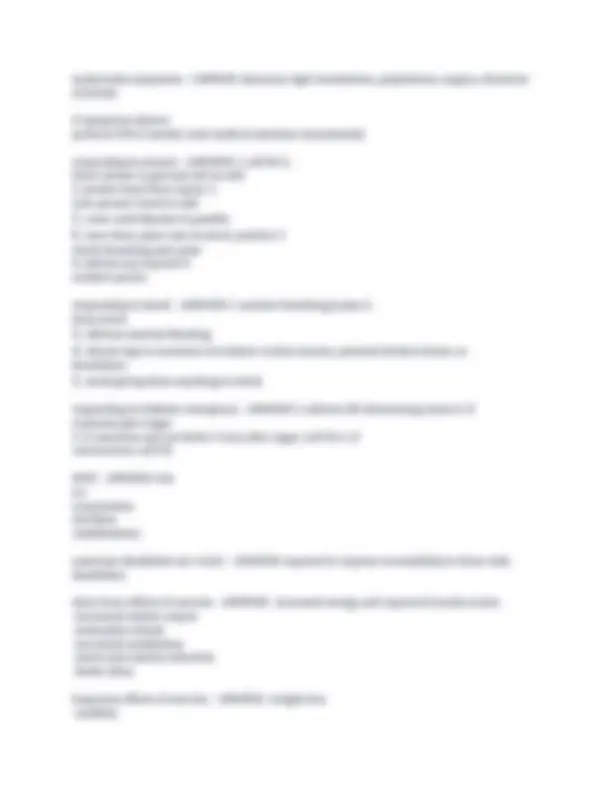
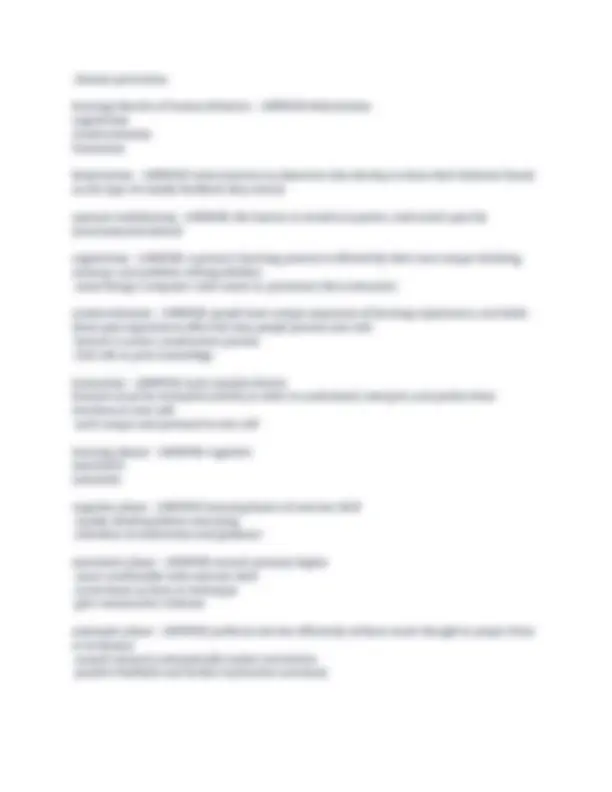
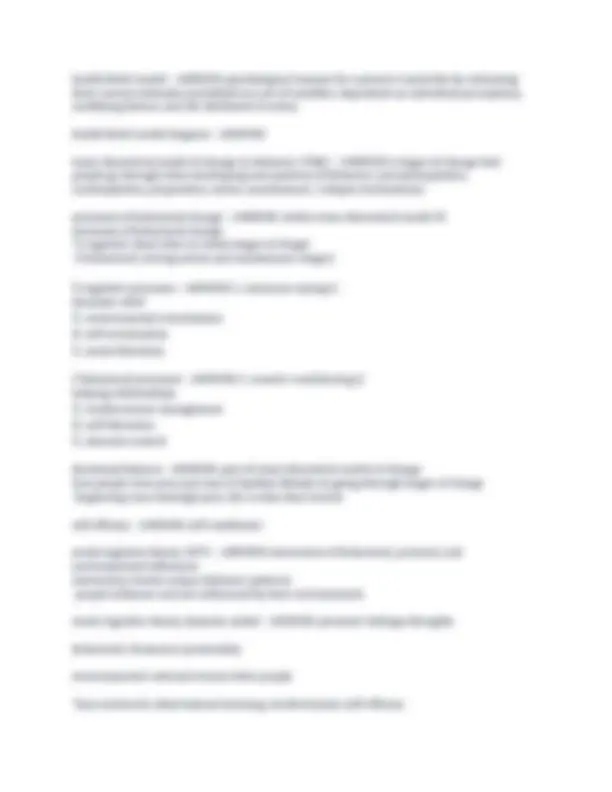
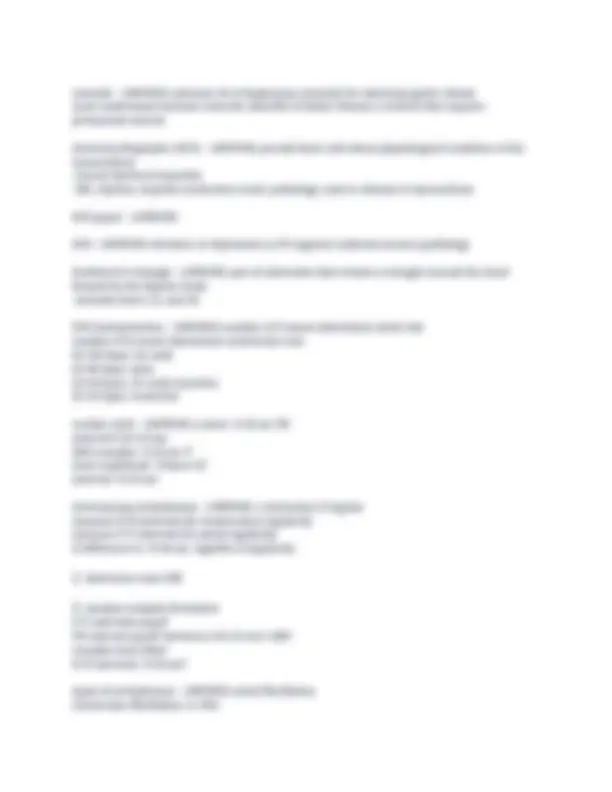
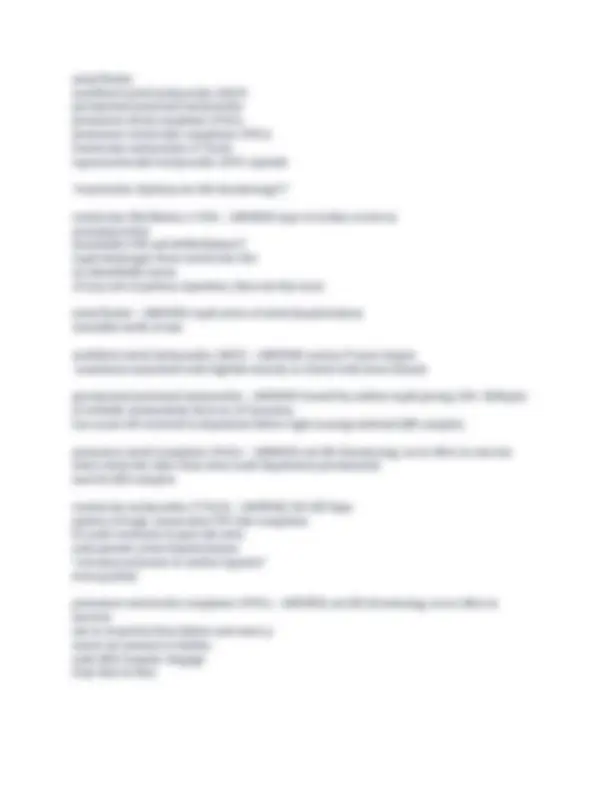
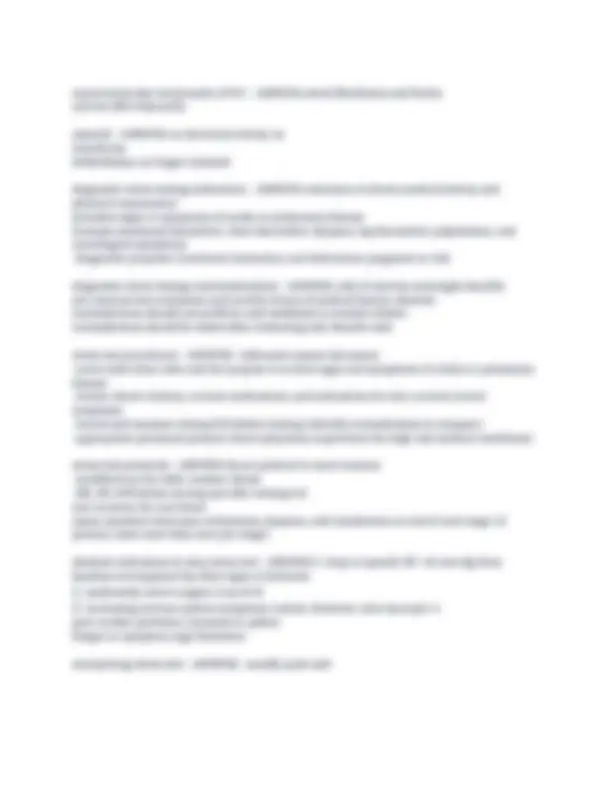
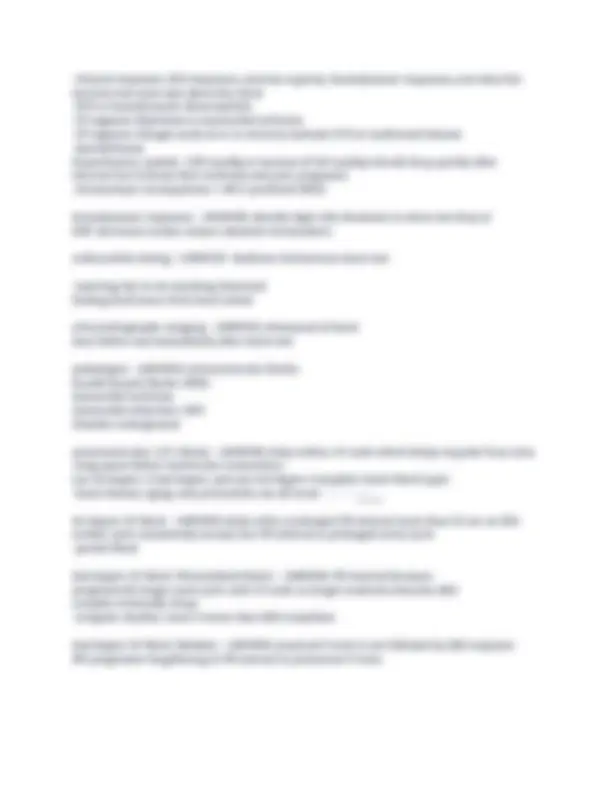
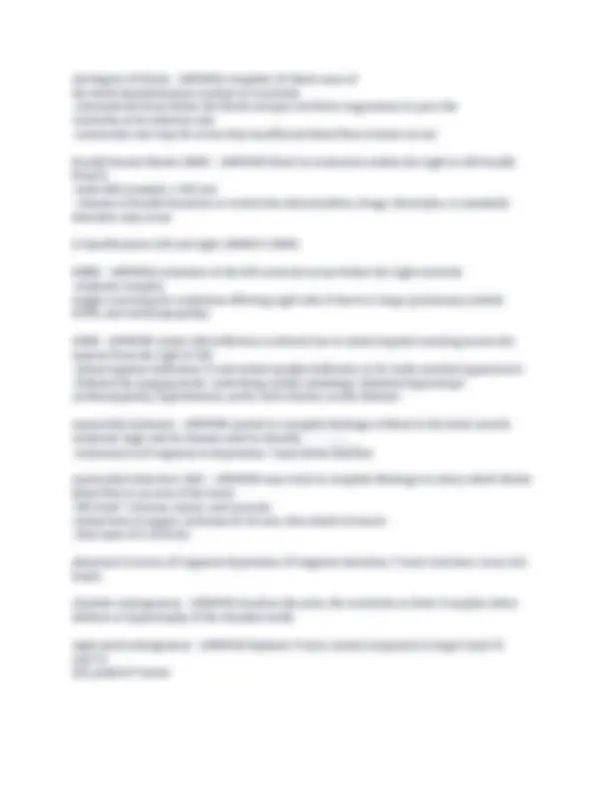
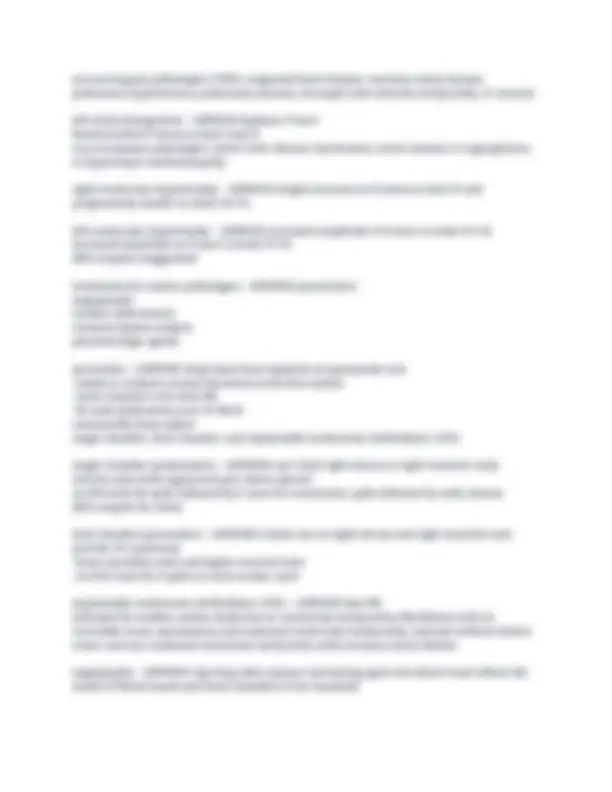
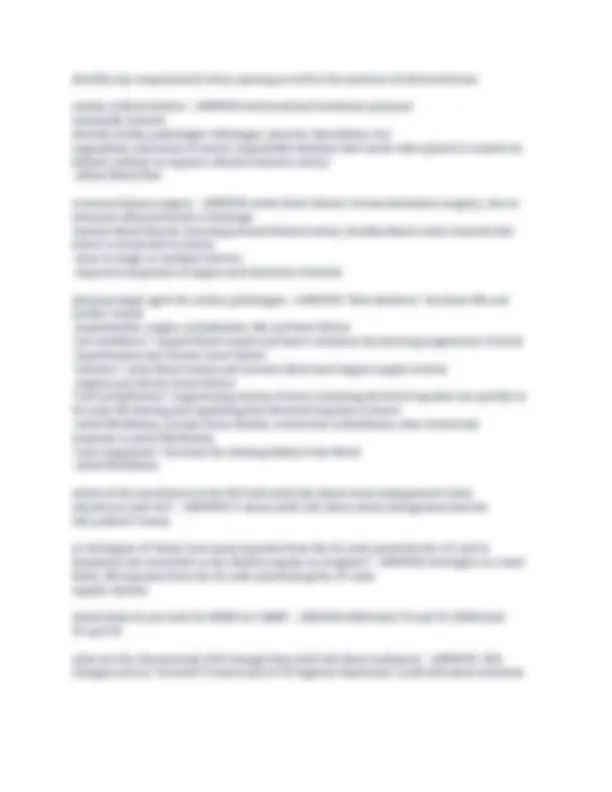
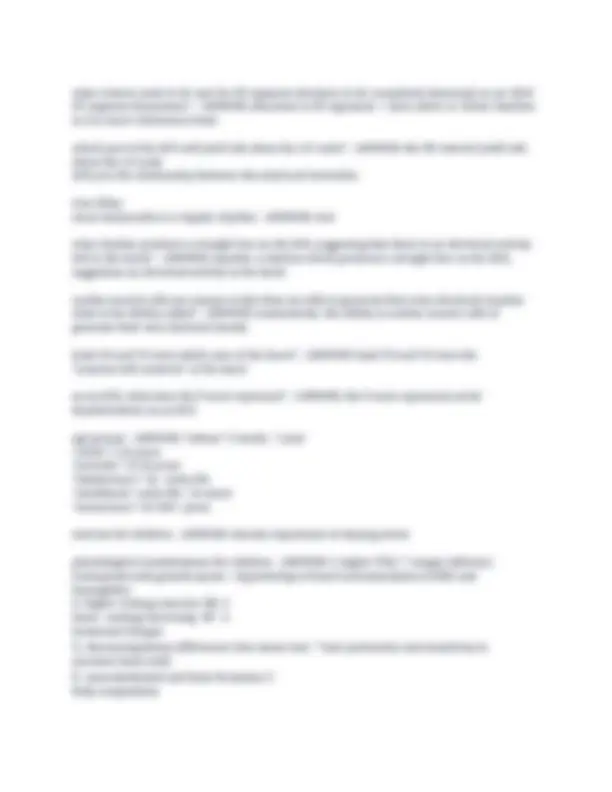
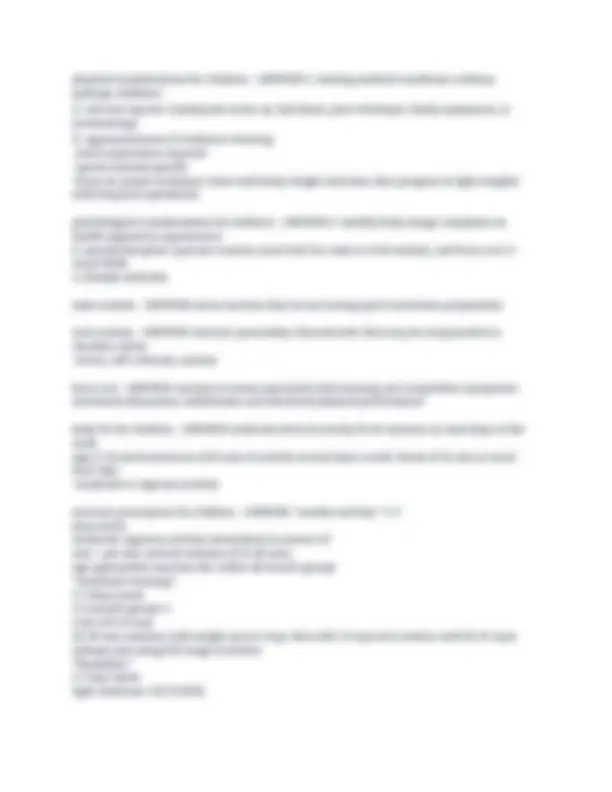
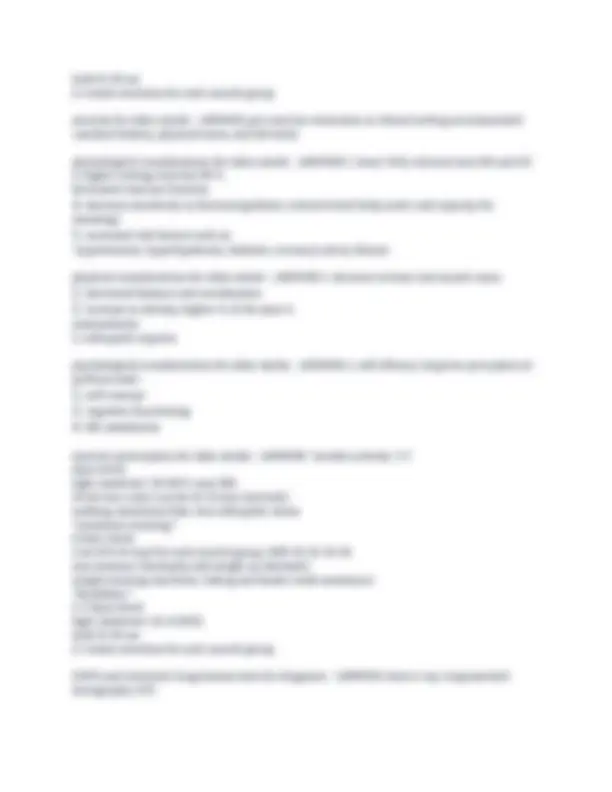
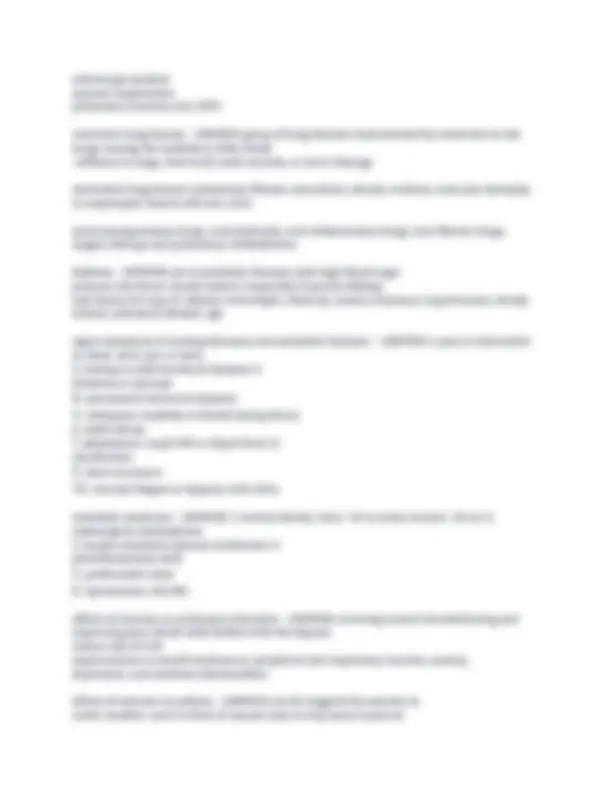
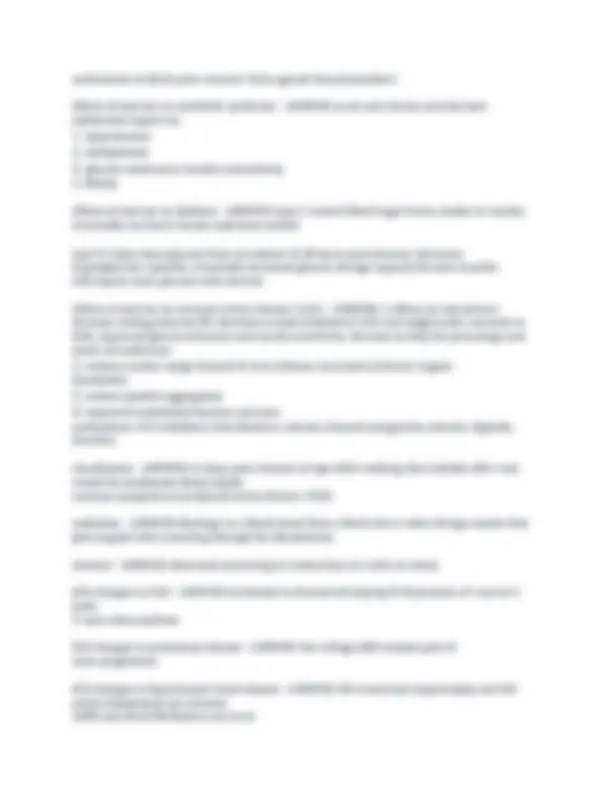
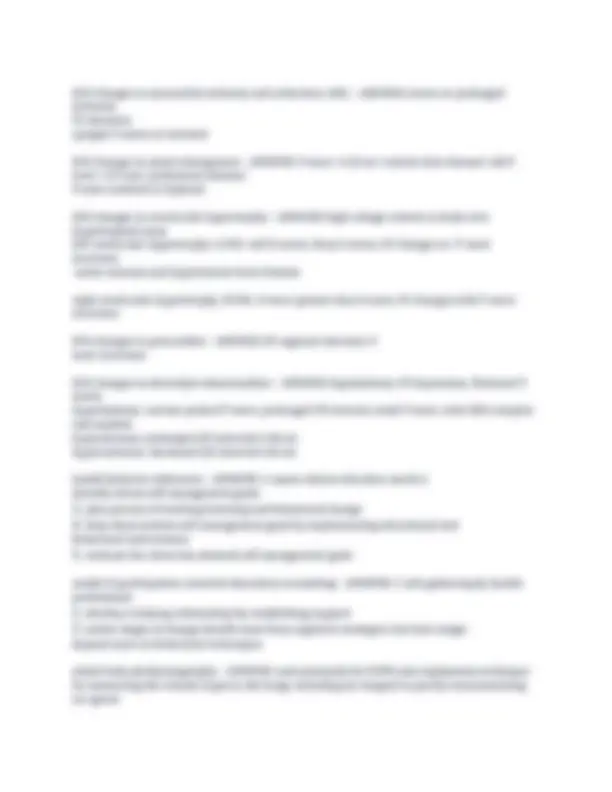
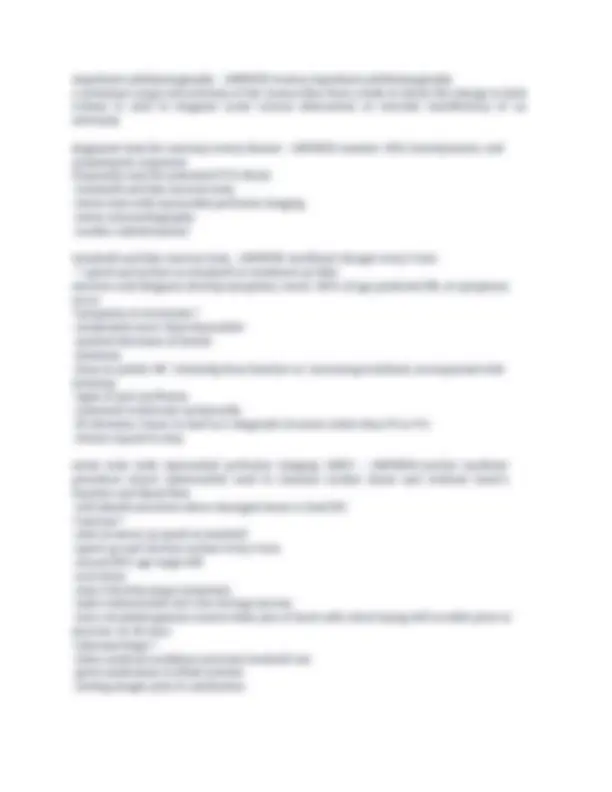
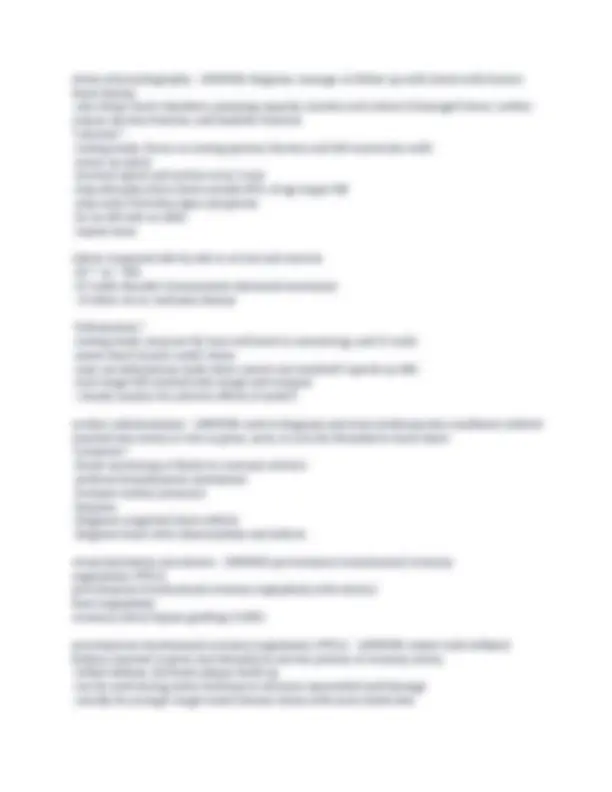
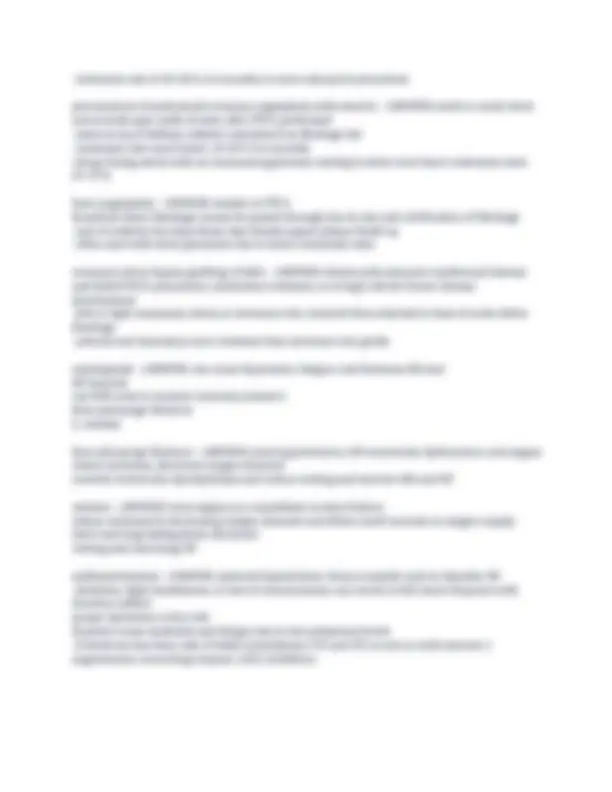
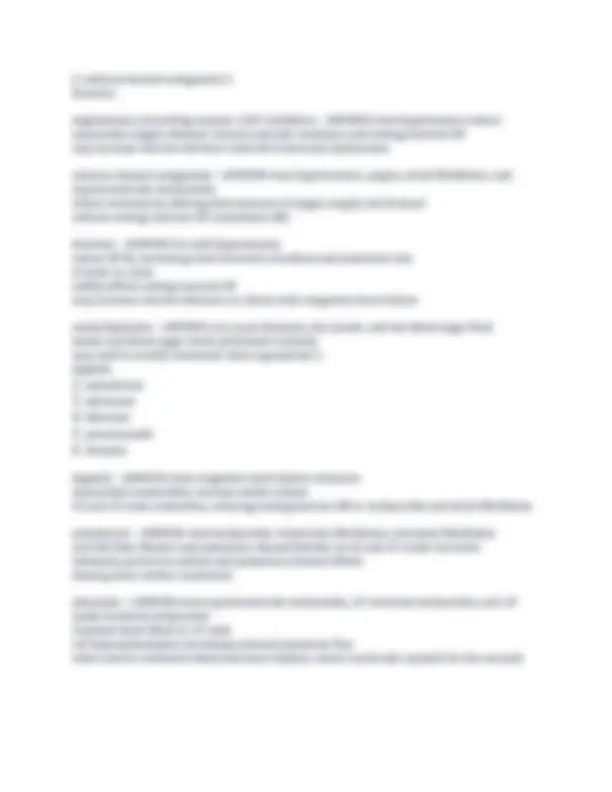
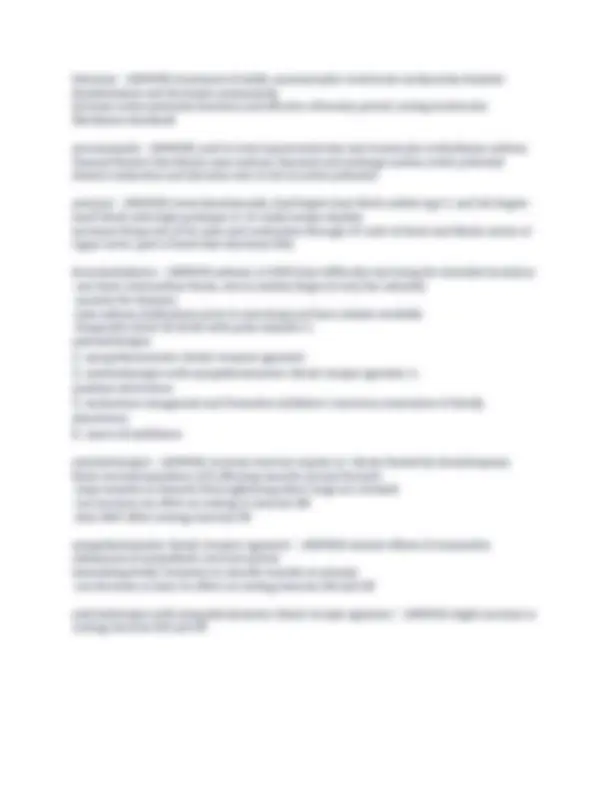
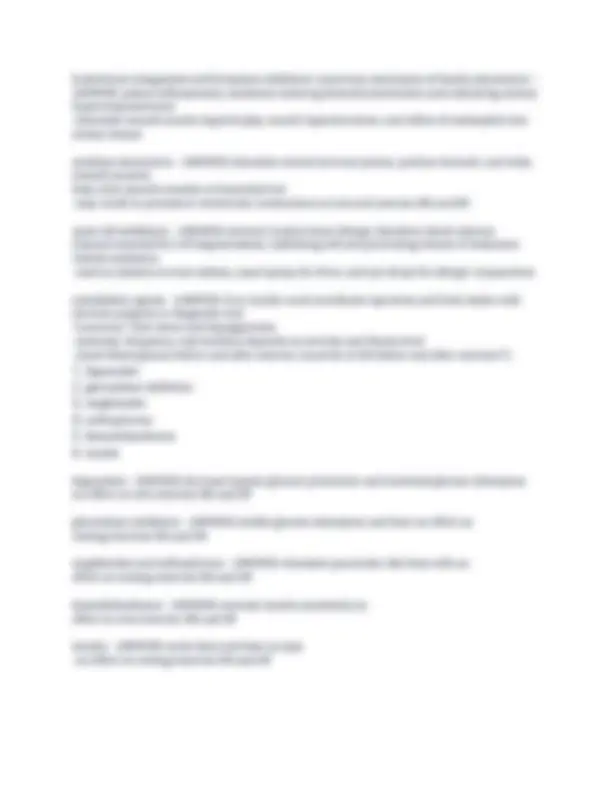
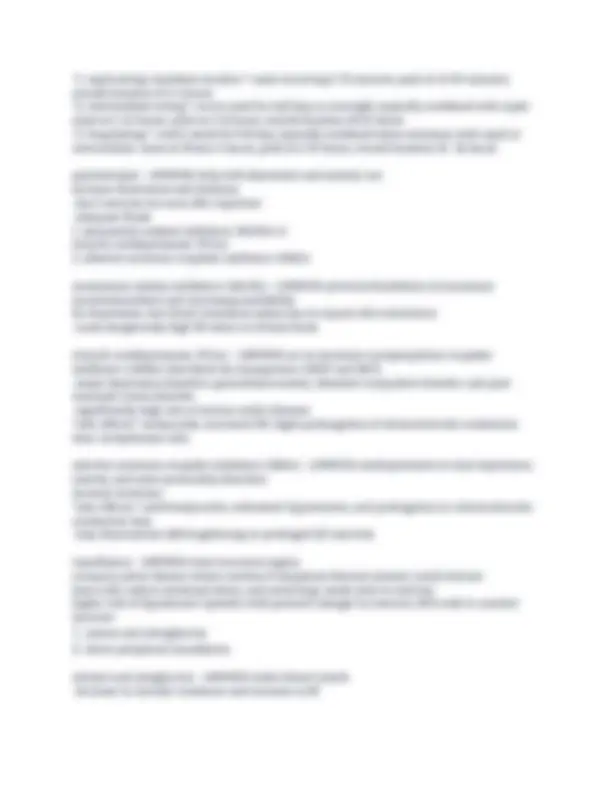
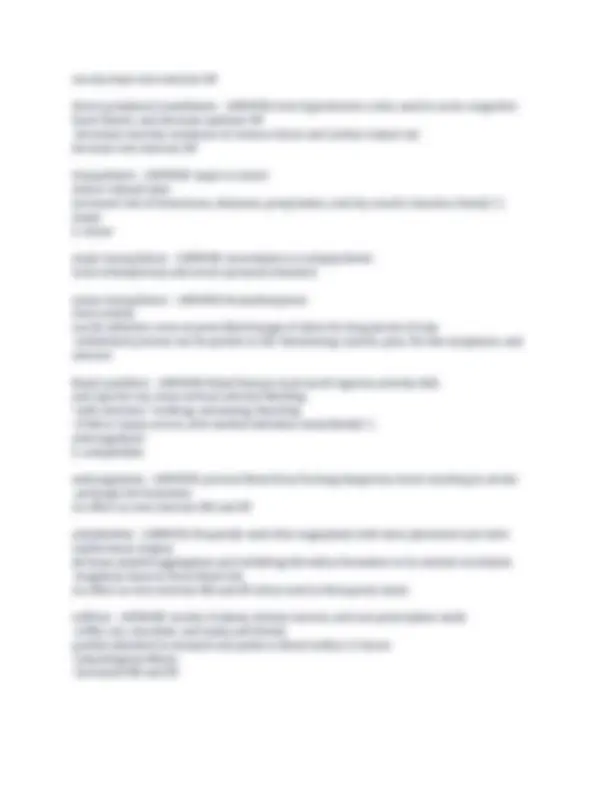
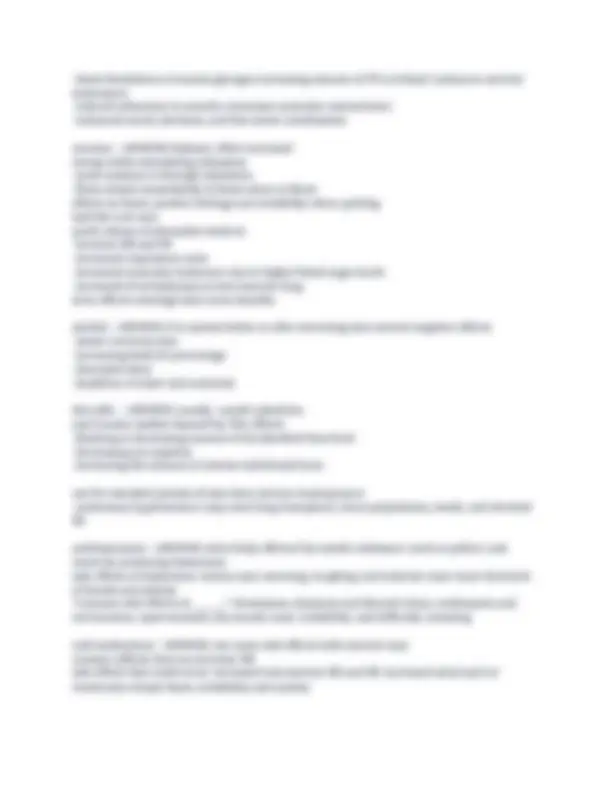


Study with the several resources on Docsity

Earn points by helping other students or get them with a premium plan


Prepare for your exams
Study with the several resources on Docsity

Earn points to download
Earn points by helping other students or get them with a premium plan
Community
Ask the community for help and clear up your study doubts
Discover the best universities in your country according to Docsity users
Free resources
Download our free guides on studying techniques, anxiety management strategies, and thesis advice from Docsity tutors
ACSM Personal Trainer Certification Exam Review 2024 pretest considerations for healh appraisal - ANSWER-systematic approach in screening clients for: signs and symptoms, family history, risk factors for disease informed consent - ANSWER-an agreement to do or allow something to occur, made with an awareness of relevant facts, including: procedures, risks, benefits, limitations, and discomforts -legal and ethical document -often paired with release of liability form Par-Q - ANSWER-used for screening Physical Activity Readiness Questionnaire minimal standard for moderate intensity exercise 7 questions; if answered "yes" to any question, then require to get medical release form from healthcare provider physician referral - ANSWER-safeguard for high risk clients who may compromise health with exercise without medically trained staff -physician's name, stating diagnosis, and exercise perscription
Typology: Exams
1 / 48

This page cannot be seen from the preview
Don't miss anything!









































pretest considerations for healh appraisal - ANSWER-systematic approach in screening clients for: signs and symptoms, family history, risk factors for disease informed consent - ANSWER-an agreement to do or allow something to occur, made with an awareness of relevant facts, including: procedures, risks, benefits, limitations, and discomforts -legal and ethical document -often paired with release of liability form Par-Q - ANSWER-used for screening Physical Activity Readiness Questionnaire minimal standard for moderate intensity exercise 7 questions; if answered "yes" to any question, then require to get medical release form from healthcare provider physician referral - ANSWER-safeguard for high risk clients who may compromise health with exercise without medically trained staff -physician's name, stating diagnosis, and exercise perscription risk stratification - ANSWER-assigns individuals to low, medium, or high risk based on presence of conditions ACSM risk stratification matrix - ANSWER-makes recommendations based upon low, moderate, or high risk clients positive risk factors - ANSWER-family history of disease cigarette smoking hypertension hyercholesterolemia/dyslipidemia impaired fasting glucose obesity sedentary lifestyle family history of disease - ANSWER-myocardial infarction, coronary revascularization, or sudden death before age 55 in males and 65 females (1st degree relatives) cigarette smoking - ANSWER-currently smoking or quit withing 6 months, or exposed to 2nd hand smoke over 6 months
hypertension - ANSWER-clients currently taking antihypertensive medication and/or confirmed (2 separate occasions) 140/90 BP or higher hypercholesterolemia/dyslipdemia - ANSWER-clients currently taking lipid lowering medication and/or those with total serum cholesterol >200 mg/dL, or high density lipoprotein cholesterols of 0.35 mg/dL impaired fasting glucose - ANSWER-fasting blood glucose > or equal to 110 mg/dL (2 separate measurements) obesity - ANSWER-BMI > or equal mg/m^2 or waist girth exceeding approximately 39. inches sedentary lifestyle - ANSWER-those not meeting recommended amount of physical activity (at least 30 minutes of physical activity at a moderate intensity 40-60%, at least 3 days a week for at least 3 months) negative risk factors - ANSWER-high serum HDL cholesterol: >60 mg/dL emerging risk factors - ANSWER-inflammatory markers: reactive C protein (CRP) and fibrinogen low risk - ANSWER-men <45, women <55, asymptomatic, with 1 or less risk factors A) current medical examination and exercise testing prior participation- not necessary for moderate or vigorous exercise B) physician supervision of exercise tests- not necessary for submax or maximal tests moderate risk - ANSWER-men >45, women >55, or those who meet the threshold for 2 or more risk factors A) current medical examination and exercise testing prior participation- not necessary for moderate but recommended for vigorous exercise B) physician supervision of exercise tests- not necessary for submax but recommended for maximal tests high risk - ANSWER-1 or more signs and symptoms listed or a known cardiovascular, pulmonary, or metabolic disease A) current medical examination and exercise testing prior participation- recommended for moderate or vigorous exercise B) physician supervision of exercise tests- recommended for submax or maximal tests exercise testing steps - ANSWER-M.R.I.P.L. medical history risk factor assessment interpreting the data (cardio endurance, muscle strength/endurance, flexibility, body comp) prescribing exercise program
occurring with exertion and going away with rest can be triggered by mental or emotional stress could feel like indigestion and spread to arms, back, or other areas unstable angina - ANSWER-medical emergency occurs even at rest and usually more severe and longer lasting (as long as 30 minutes) -may signal heart attack!!! arrhythmias - ANSWER-abnormal heart rhythm: -tachycardia -bradycardia -atrial fibrillation -ventricular ectopic beats (VEB tachycardia - ANSWER-very fast heart rate sinus: >100 bpm atrial: >100 bpm with narrow QRS complex, w/ P waves originating not from sinus node ventricular: potentially life threateing, >100 bpm, with at least 3 irregular heartbeats in a row (ventricular fibrillation, asystole, or death) bradycardia - ANSWER-unusually slow heart rate (less than 60 bpm) atrial fibrillation (A-fib) - ANSWER-irregular heart rhythm -continuous rapid firing of atrial foci -no P waves -does not completely depolariaze -series or erratic tiny spikes ventricular ectopic beats (VEB) - ANSWER-heartbeat arising from an abnormal focus. Called premature beats (before next schedule heart beat) or escape beats (later than next scheduled heart beat) dyspnea - ANSWER-shortness of breath (SOB). difficult or uncomfortable breathing experienced subjectively. can occur at rest or be cause by exertion exertion cause dyspnea - ANSWER-suggests presence of cariopulmonary disorders (especially left ventrifular dysfunction or chronic obstructive pulmonary disease) -tachypnea -hyperventilation -hyperpnea tachypnea - ANSWER-increase in respiratory rate above normal
hyperventilation - ANSWER-increase minute ventilation relative to metabolic need hyperpnea - ANSWER-disproportionate rise in minute ventilation relative to an increase in metabolic level unilateral edema - ANSWER-a limb completely swollen, often cause by venous thrombosis or lymphatic blockage in limb ankle edema - ANSWER-most common, sign of heart failure or bilateral chronic venous insufficiency heart murmur - ANSWER-usually harmless cause by blood flowing through a damage or overworked heart valve can indicate valvular abnormalities intermittent claudication - ANSWER-muscle with inadequate blood supply being stressed by exercise, causing pain -doesn't occur when standing/sitting, more severe when walking upstairs/hill symptoms: often described as a cramp, disappears couples minutes after stopping exercise paroxysmal nocturnal dyspnea (PND) - ANSWER-dyspnea that occurs after 1-2 hours of sleep symptoms: wheezing/coughing that wakes client up; usually relieve once awake to sit up or productively cough syncope - ANSWER-fainting or sudden loss of consciousness caused by lack of blood supply to the cerebrum -fall in BP -when accompanied with dizziness may result from cardiac disorders preventing normal cardiac output: severe coronary artery disease, hypertrophic cardiomyopathy, aortic stenosis, and malignant ventricular dysrhythmias palpitations - ANSWER-fluttering, rapid, or punding sensations in the chest related to cardiac arrhythmias, such as premature ventricular contractions (PVCs) -usually harmless -triggered by stress, exercise, or medication if accompanied with chest pain/discomfort, fainting, shortness of breath, and/or severe dizziness seek emergency medical attention indication - ANSWER-valid reason to use certain tests, medications, procedures, etc. contradictions - ANSWER-conditions or facts requiring the withholding of certain medical treatments or tests absolute contradictions - ANSWER-do not perform exercise test!
isometric - ANSWER-muscle contraction without shortening or changing distance between the origin and insertion isokinetic - ANSWER-concentric muscle or eccentric muscle in which the speed and tension are constant throughout the range of lengthening or contractin 1 RM testing - ANSWER-1. cover movement, then do light warm up 5-10 reps of light- moderate exertion
resistance training guidelines - ANSWER-at least 2 days/week for 45-60 min consist of 3 set of 12-15 reps 30 sec rest period 7-0 moderate exercises intensity measurements - ANSWER-heart rate METs VO2 max aerobic activity for healthy population - ANSWER-3-5 days/week on consecutive days, alternate with another mode 20-60 min of continuous activity volume of workload - ANSWER-duration and frequency of the activity performed within the time frame allotted for the training process cardio benefits - ANSWER-decrease obesity, hypertension, type II diabetes, depression increase immunity, blood lipids, glucose tolerance, and a sense of well being average VO2 - ANSWER-sedentary: 35 ml/kg/min athlete: 70 ml/kg/min can improve by increasing training volume and intensity MHR formula (Maximum Heart Rate) - ANSWER-206.9 - (0.67 * age) EX) 206.9 - (0.67 X 21) = 192. Karvonen formula - ANSWER-(MHR - RHR) * intensity = + RHR = desired intensity EX) 25 year old with RHR being 65 bpm 206.9 - (0.67 X 25) = 190 MHR 190 - 65 = 125 125 X .65 = 75 + 65 = 140 125 X .85 = 106 + 65 = 171 target heart rate zone = 140-171 bpm METs calculation - ANSWER-women: 14.7 - (0.13 X age) = target men: 14.7 - (0.11 X age) = taret BMI - ANSWER-obesity related problem when > mild obesity = 25- moderate obesity = 30- severe obesity = 35+ linear periodization - ANSWER-continual progression of increasing intensity. The amount of weight is increase as the reps are decreased
horizontal loading - ANSWER-completing all sets of an exercise before moving on to the next exercise vertical loading - ANSWER-completing one set of all exercises before beginning the second set proper breathing - ANSWER-breath diaphragmatically during aerobic activity (through stomach) -if clients cannot switch to proper breathing pattern, refer them to a health care professional inhale concentric exhale eccentrically valsalva maneuver physiological response - ANSWER-initial pressure rise first 5-10 sec reduced venous return and 15-20 sec compensation 20-23 sec pressure relief 24 sec + return of cardiac output eccentric contraction - ANSWER-strongest of 3 muscle actions target heart rate zones - ANSWER-zone 1: recovery zone 40-60% zone 2: aerobic zone 65-85% zone 3: peak zone 85%+ exercise perscription components - ANSWER-mode intensity duration frequency progression target heart range for moderate activity - ANSWER-50-70% of max HR specificity principle - ANSWER-exercising a certain body part that develops primarily that part must perform exercise/skill to improve on exercise/skill overload principle - ANSWER-body easily adapts to increase or decreased physical demand, enabling people to develop muscle coordination and sports-specific skills adaption principle - ANSWER-greater stress than normal is required for adaption to occur to improve fitness/strength/endurance, then workload must increase accordingly progression principle - ANSWER-optimal overload level and optimal time frame for overload to occur if overload is too slow, then less improvements
if overload too fast could cause injury or muscle damange adequate rest and recover cardiovascular disease (CVD) - ANSWER-any disease that affects the heart or blood vessel increase risk of heart attack, heart failure, sudden death, high blood pressure, stroke, and cardiac rhythm problems preventable/treatable: high blood pressure, high cholesterol, excess weight, diabetes, physical inactivity, metabolic syndrome, smoking, excessive alcohol consumption, illegal drug use, and stress nonpreventable/treatable: previous heart attack, family history of heart disease, increasing age, gender, and race athersclerosis - ANSWER-plaque formation lipid deposits i medium-large sized arteries sedentary lifestyle, diet with high intake of saturated fat, high blood pressure, smoking, and any other toxic agent to the body -endothelial cells of artery can be damaged -increased risk of heart attack obese statistics - ANSWER-1/3 adults 1/ young people ages 6- type II diabetes cons - ANSWER-can increase risk of: affected blood vessels and nerves including: vision impairment, kidney disease, peripheral vascular disease, atherosclerosis, and hpertension chronic diseases - ANSWER-NEED PHYSICIAN APPROVAL BEFORE EXERCISE PROGRAM -or ever exercise recommendations aerobic exercise benefits - ANSWER-conditions heart and lungs by increasing amount of oxygen the heart uses more efficiently -decrease risk of heart disease and stroke -positive effect in decreasing blood cholesterol levels and blood pressure resting metabolic rate - ANSWER-accounts for up to 75% of daily calories. increase in muscles requires more calories to maintain, which mean the higher your high blood pressure and resistance training - ANSWER-use lighter weights with more reps consider consulting physician for strength training routine borg scale - ANSWER-walking or cycling = level 13 strength activities = levels 15-
heart attack symptoms - ANSWER-MEDICAL EMERGENCY, CALL 911 chest discomfort pain/discomfort in one or both arms, neck, back, jaw, or stomach shortness of breath with or without chest discomfort breaking out in a cold sweat feeling nauseous or lightheaded hypothermia symptoms - ANSWER-MEDICAL EMERGENCY, CALL 911 exhaustion or drowsiness shivering confusion memory loss fumbling hands slurred speech chronic obstructive pulmonary disease (COPD) - ANSWER-a group of lung diseases that block airflow upon exhalations; difficult to breathe or dyspnea -higher altitude = less oxygen to inhale conditions: emphysema, chronic asthmatic bronchitis, asthma, cystic fibrosis medications (bronchodialators, steroids, and antibiotics), supplement oxygen, pulmonary rehabilitation; with severe emphysema can do lung volume reduction surgery or lung transplant exercise programming cardio recommendations - ANSWER-moderate intensity 55-69% high intensity 70-89% -new to exercising clients begin at 55% 20-60 min 3-5 days/week strength training recommendations - ANSWER--involve 8-10 exercises for major muscles with at least one set per exercise -8-12 reps per set for 2-3 nonconsecutive training days/week -full range movements that are pain free -moderate speed body weight exercises - ANSWER-pros: can be performed anywhere without equipment cons: difficult to increase resistance easily and target specific muscle groups resistance machine exercises - ANSWER-pros: allow client to control resistance and isolate specific muscles cons: requires special equipment free weight exercises - ANSWER-pros: client controls resistance, isolate specific muscles, and improve muscle balance
cons: not mechanically supported so risk of injury is higher bioenergetics - ANSWER-process of transferring energy from foods throughout the body, supplying the contracting muscles with usable energy: ATP phosphagen system - ANSWER-uses immediate stored energy inside the muscle cell -ATP and phosphocreatine (PCR) EX) sprinting and weightlifting no more than 30 sec nonoxidative system (anaerobic) - ANSWER-AKA lactic acid or glycolytic system short term energy system ATP and phosphocretine to be re-synthesized at a rapid rate uses carbs (glucose and glycogen) for ATP production -byproduct: lactic acid produced when carbs breakdown w/o oxygen EX) running upstairs 30 sec - 3 min high intensity effort oxidative system (aerobic) - ANSWER-long term energy system produces large amounts of ATP breaks downs carbs and fats -byproducts: water and carbon dioxide when broken down w/ oxygen EX) running marathon, hiking >3 min anaerobic/ lactate threshold - ANSWER-when working muscle demands more ATP than is being provided, the muscles will rely on the nonoxidative system for energy along with oxidative system erythrocytes - ANSWER-red blood cells -contains hemoglobin hematocrit - ANSWER-blood test to measure erythrocytes (RBC) within blood -slightly higher in men due to testosterone leukocytes - ANSWER-white blood cells -body's defense system hyperemia - ANSWER-increased amount of blood flow to working muscle of the body ^exercise = ^oxygen and nutrient delivery to muscles -increases waste removal (lactate and carbon dioxide) cardiovascular drift - ANSWER-prolonged endurance exercise increases body temp plasma moved from blood to tissue to promote sweating -can cause increased HR, and decreased stroke volume and volume of blood
ejection fraction - ANSWER-% of blood in ventricle when heart is in a relaxation (diastolic) state but this blood actually gets pumped out during the contraction (systolic) phase frank-starling law - ANSWER-amount of blood left in each ventricle after end diastolic volume will significantly affect the stroke volume -every contraction creates a greater stretch on heart muscles; contractile force wil eventually increase normal EDV ~125 ml normal ESV ~55ml minute ventilation - ANSWER-volume of air breathed in 1 min at rest ~6 L/min -per breath is tidal volume (0.5L - 4 L) shunting - ANSWER-when blood is shunted away from all vital organs of body to exercising muscles axial skeleton - ANSWER-skull vertebral column ribs sternum (supports and protects vital organs) appendicular skeleton - ANSWER-arms legs pelvis pelvic girdle (provides movement and support) spine - ANSWER-33 vertebrae: -7 cervical -12 thoracic -5 lumbar -5 sacral -4 coccygeal scoliosis - ANSWER-abnormal curve of spine in frontal plane kyphosis - ANSWER-outward curve on spine causing hunch thoracic and sacral region -develops as fetus lordosis - ANSWER-inward curve on spine cervical and lumbar regions -develops after birth
tendons - ANSWER-muscle to bone ligaments - ANSWER-bone to bone sliding filament theory - ANSWER-theory of muscle contraction; sarcomeres shorten when thick filaments pull on thin filaments length tension relationship - ANSWER-The resting length of a muscle and the tension the muscle can produce at this resting length. -produce greatest tension at resting length (how much contracted/lengthened dependent on force) type I muscle fibers - ANSWER-slow twitch most resistant to fatigue produce large amounts of ATP w/oxygen developed through training and genetics -marathon runners type IIA muscle fibers - ANSWER-fast twitch produce bursts of power fatigue quickly ATP produced w/o oxygen ATP broken down rapidly -sprinters type IIB muscle fibers - ANSWER-combo of Type I and Type II fibers ATP produced w/ and w/o oxygen produce fast.strong muscle contractions more prone to fatigue that type I -resistance training sagittal plane - ANSWER-divides body into left and right sides -flexion and extension -rotates around mediolateral axis (perpendicular) EX) walking or squatting transverse plane - ANSWER-divides body into superior and inferior portion -internal/external rotation, horizontal flexion/extension, and supination/pronation -rotates around longitudinal axis (perpendicular) EX) throwing baseball or golf swing frontal (coronal) plan - ANSWER-divides body into anterior and posterior portions -abduction/adduction, side flexion, and inversion/eversion -rotates around anteroposterior axis (perpendicular) EX) side bending, and lateral arm lifts
mark sites measure for 4 seconds measure to nearest 1/2 - 1 mm 2 measurements of each site in rotational order and averaged (difference more than 1 mm = measure again) women skinfold sites - ANSWER-triceps suprailium thigh mens skinfold sites - ANSWER-chest ab thigh bioelectrical impedance analysis (BIA) - ANSWER-fluid is capable of electrical conduction, safe, low level current flows through body fluids to determine body comp -clients lies flat on table no limbs touching w/ electrodes on hands and feet -more lengthy and expensive than skinfold implications of BIA - ANSWER-min reccomended level of total body fat: men: 5% women: 15% optimal health: men: 10-25% women: 18-30% lower ranges for athletes ideal wait-hip ratios - ANSWER-women 18-59: <0. women 60+: <0. men 18-59: <0. men 60+: <1. positive health affects for women maintaining ideal WHR - ANSWER-optimal levels of estrogen lowered susceptibility to diabetes, cardio disorders, and ovarian cancer positive health affects for men maintaining ideal WHR - ANSWER-higher fertility lower susceptibility to prostate and testicular cancers 4 criteria for anorexia nervosa diagnosis - ANSWER-1. refuse to maintain body weight or body weight during growth period 15% lower than anticipated